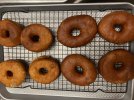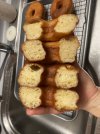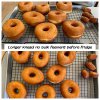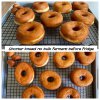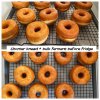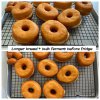I have a recipe which I thought I was happy with however my donuts are shrinking/not keeping a uniform shape, they are blistering, and I’m not getting an even white ring around them.
Recipe/method is
177mls full cream milk
50grams of sugar
Bring to boil
Add
113grams butter
until melted
Bring down to room temp (which is about 26/27 degrees Celsius)
Add
60ml water
7grams active dry yeast
1 egg
Pour into mixing bowl and add
475 grams flour (I use 12.5% protein flour)
25grams diastatic malt powder
1 tsp salt
1/4 tsp nutmeg
mix until passed window pane test
Let double
Knock down
Place in fridge overnight
Fold on itself 3-4 times
Roll to 11ml thick, cut shapes
Proof at room temp (around 30/31degrees and in the80% humidity - I live in a hot place)
Fry at 180-190 (I set my fryer to 190 but it drops between 180-190)
After following some advice on another thread I made the following adjustments to the recipe
- remove water, add extra milk
- use correct DDT
- replace instant dry yeast with dry yeast
- remove diastatic malt powder
- knead less
After making the above changes I did as follows
With the dough I split it in two and put half right into the fridge and half I left out for the first rise.
Once the first rise had finished I knocked the dough back then placed it in the fridge.
When I took the dough out I split each half into half again.
Then for the dough that had received no first proof I lightly kneaded half rolled it out and cut my rings.
The other half I tipped onto the bench and rolled it without any kneading and cut it into shapes.
I repeated the above with the half of the dough I had allowed to have a first rise.
My results - obviously these changes made my results worse but I’m not sure what else to adjust to get the desired results
The photo of the donuts on the trolley is how my donuts were turning out before I made any adjustments to the recipe.
The donuts which received no first proof and no knead before rolling out kept their shape well but did not puff up when fried.
The donuts which received no first proof and had a light knead before rolling out shrunk, but did puff up when fried.
The donuts which received a first proof and no knead before rolling out kept their shape well but did not puff up when fried.
The donuts which received a first proof and had a light knead before rolling out shrunk, but did puff up when fried.
Surprisingly they all have an ok texture
HELP? Do I just stick with my original donuts and accept they aren’t uniform coz I’m not a machine? Or is there a way to make them aesthetically pleasing?
Recipe/method is
177mls full cream milk
50grams of sugar
Bring to boil
Add
113grams butter
until melted
Bring down to room temp (which is about 26/27 degrees Celsius)
Add
60ml water
7grams active dry yeast
1 egg
Pour into mixing bowl and add
475 grams flour (I use 12.5% protein flour)
25grams diastatic malt powder
1 tsp salt
1/4 tsp nutmeg
mix until passed window pane test
Let double
Knock down
Place in fridge overnight
Fold on itself 3-4 times
Roll to 11ml thick, cut shapes
Proof at room temp (around 30/31degrees and in the80% humidity - I live in a hot place)
Fry at 180-190 (I set my fryer to 190 but it drops between 180-190)
After following some advice on another thread I made the following adjustments to the recipe
- remove water, add extra milk
- use correct DDT
- replace instant dry yeast with dry yeast
- remove diastatic malt powder
- knead less
After making the above changes I did as follows
With the dough I split it in two and put half right into the fridge and half I left out for the first rise.
Once the first rise had finished I knocked the dough back then placed it in the fridge.
When I took the dough out I split each half into half again.
Then for the dough that had received no first proof I lightly kneaded half rolled it out and cut my rings.
The other half I tipped onto the bench and rolled it without any kneading and cut it into shapes.
I repeated the above with the half of the dough I had allowed to have a first rise.
My results - obviously these changes made my results worse but I’m not sure what else to adjust to get the desired results
The photo of the donuts on the trolley is how my donuts were turning out before I made any adjustments to the recipe.
The donuts which received no first proof and no knead before rolling out kept their shape well but did not puff up when fried.
The donuts which received no first proof and had a light knead before rolling out shrunk, but did puff up when fried.
The donuts which received a first proof and no knead before rolling out kept their shape well but did not puff up when fried.
The donuts which received a first proof and had a light knead before rolling out shrunk, but did puff up when fried.
Surprisingly they all have an ok texture
HELP? Do I just stick with my original donuts and accept they aren’t uniform coz I’m not a machine? Or is there a way to make them aesthetically pleasing?







